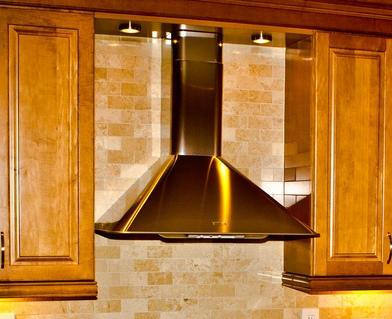How Can You Get Carbon Monoxide Poisoning From a Range Hood?
0 Comments | Posted by armchairbuilder in Fix it!, Quality Check
How can you get carbon monoxide poisoning from a range hood?, Guest Post by James Toon.
So, how can you get carbon monoxide poisoning from something as simple as a range hood? Large, stainless steel range hoods are the centerpiece of many modern kitchens. Gone are the days of small, under-cabinet hoods. Everyone wants a kitchen that looks like that of a five-star restaurant. But there are unintended consequences for installing such large (often powerful) ventilation appliances in a residential kitchen.
The Makeup Air Problem
Range ventilation hoods often move more exhaust air out of your home than any other appliance. Any volume of air you push out has to be replaced by air coming in. Historically, less energy-efficient homes were draftier, so new “makeup air” could enter the home through cracks around doors and windows. But how can you get carbon monoxide poisoning from this makeup air?
Now that homes are more airtight, the air pressure inside the home can actually be reduced significantly compared to that outside when the range hood fan is on. Compounding the problem is the fact that larger, more powerful range hoods have become popular in new and remodeled kitchens. When a 1,200-cfm hood is put into a kitchen that really only needs a 150- to 250-cfm hood, the depressurizing effect can become severe.
Carbon Monoxide Backdraft
So, why is this depressurization a problem in a home and how can you get carbon carbon monoxide poisoning from it? Well, when the pressure inside your house is lower, outside air is often pulled in through other exhaust routes, like water-heater flues, chimneys and dryer vents. This backward air-flow is called “backdrafting,” and it can push poisonous carbon monoxide into the home when it should be venting outward. Powerful backward air flow in a dryer vent could also push flammable lint back into a gas-burning clothes dryer.
The solution to this problem isn’t just about cracking a window. Even if homeowners remember to open a window or door while operating a hood fan, a fully-opened window often can’t provide adequate air-flow to stop backdrafting. Many building codes require that makeup air be provided by installing some type of vent or damper.
Little Help from Manufacturers
Contractors, installers and homeowners have been complaining about the backdrafting problem for a while, but not a lot of helpful response is coming from manufacturers on the issue. People still want that big, beautiful stainless steel range hood in their kitchen and they don’t want the dangers associated with backdrafting. However, the instructions for new hoods rarely address the requirement for makeup air directly. And few, if any, hood manufacturers are currently offering an integrated makeup air solution to the problem. So, hopefully we’ve answered your question, how can you get carbon monoxide poisoning from a range hood? But how do you address the problem?
Currently, the best solution appears to be some type of damper installed to provide air flow while the range hood is venting. Makeup air dampers are available which open to allow additional air-flow into the home, but they often have to be turned on separately before turning on the range hood fan. Ideally, the damper should be part of the range hood installation, with the damper opening or closing whenever the hood fan turns on or off.
Consult your contractor and see what options are available for your home and kitchen style for setting up an automatic damper. Somehow, you’ll need to get adequate ventilation to prevent backdrafting harmful exhaust into your home, and a competent contractor should be able to wire a solution for you. Then, you can have that big range hood and vent it too. If we haven’t completely answered your question, How can you get carbon monoxide poisoning from a range hood?, you may want to check out a previous Armchair Builder article titled, Range Hoods Can Be Dangerous.
James Toon is a representative for The Range Hood Store and has years of experience helping customers build their dream kitchens.


